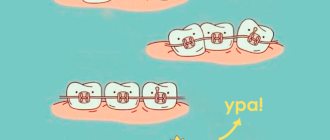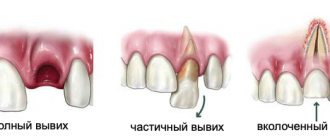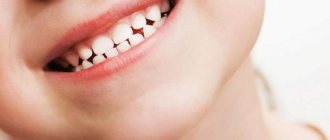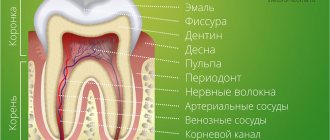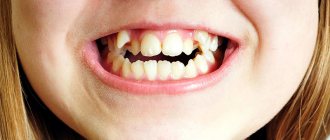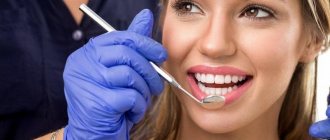Causes of curvature
There are many provoking factors that can lead to curvature of the formed row. If one or both parents have a similar problem, it will most likely affect the baby. In addition to unfavorable heredity, deformation changes are often provoked by a deficiency of nutrients in the diet of a pregnant or nursing mother, too soft food on the baby’s menu, chronic diseases accompanied by mouth breathing, bad habits and congenital anomalies.
Allergies, asthma (bronchial spasms), disorders of bone formation and lack of mineralization, dysplasia, shortened frenulum are also common reasons why a child’s first teeth grow crookedly and unevenly.
Health and nutrition problems in the expectant mother
Many women mistakenly believe that they should think about the health and well-being of their baby only after it is born. It is important to remember that all the organs of a small person are formed during intrauterine development. Before the 12th gestational week, the rudiments of vital systems are formed, so any pathological factors can lead to termination of pregnancy. However, this does not mean at all that immediately before childbirth, overeating and abuse of fatty, starchy and canned foods is encouraged.
Proper nutrition of a woman in labor plays a vital role in each trimester of pregnancy. You need to eat healthy foods rich in vitamins, minerals and other essential components.
You should take care of your health and avoid visiting crowded places, especially during seasonal epidemics. In the presence of chronic diseases and other pathologies, it is recommended to closely monitor the state of health and the results of laboratory and other tests, since the slightest deviations from the norm can lead to developmental abnormalities, and the child will develop crooked teeth.
Incorrect eating process
Newborns are fed mother's milk or an adapted formula from a bottle. In the first case, the likelihood of curvature is minimal, since in order to get food, the baby must make an effort. Such regular “training” contributes to the correct formation of the maxillofacial apparatus.
When a baby is bottle-fed, the risk of tooth curvature increases. Moms and dads buy bottles with regular nipples, which negatively affect the function and development of the jaw. The liquid pours out of the wide opening too quickly; the baby does not need to strain once again to get the next portion of food.
Late introduction of solid foods
Sometimes parents, fearing harm to the baby, try to introduce foods that need to be chewed into the diet as late as possible. This is one of the most common reasons why a child gets crooked and uneven baby teeth. He constantly feeds on milk and pureed fruits, vegetables, meat and fish purees, although he is physiologically ready to chop small pieces on his own. If the incisors and other units are not stressed by chewing, they may not grow as they should.
Bad habits
Parents should closely monitor the baby and stop all attempts to gnaw on foreign objects (with the exception of rodents specifically designed for this), bite lips, or suck fingers. It is also important to minimize pacifier use, especially if your little one is over one year old. All of these factors lead to deformation changes.
Mouth breathing
Babies breathe through their mouths when they have a cold and are unable to do so through their nose. The same thing happens with ENT diseases, chronic runny nose, adenoiditis (inflammatory process in the adenoids). As a result, the baby's tongue begins to press on the front of the jaw, which gradually becomes bent.
If the very first teeth are crooked
The first lower incisors erupt between the ages of six months and one year. They often grow in an "L" shape. This is the norm. This situation definitely does not require any treatment. By the time of complete eruption, the units are aligned and become correct.
If parents are very worried, they can speed up the process of stabilizing the position of the incisors. To do this, the baby should be given to drink from a bottle with a special tight nipple with a small hole. When using it, the baby will make more effort when sucking.
Another situation that should not worry is the even spacing between the first teeth. They disappear when the chewing units erupt. Dentists recommend paying attention only to uneven and too wide diastemas. They most often have to be closed with plates and braces.
The main causes of pathology in permanent dentition in children
Problems in which a child’s new molars come out crookedly and grow in are often observed due to curvature of the milk rows and untimely treatment. In addition, curvature appears under the influence of other factors:
- Premature removal of temporary dental units. Over time, neighboring crowns move, trying to take up the vacant space. It turns out that the new ones have to change the direction of growth.
- Bruxism. With this pathology, children's jaws involuntarily clench during sleep, during stressful situations, and during emotional outbursts. All this leads to deformations.
- Late change of bite. When replacement incisors, canines and premolars fall out untimely, permanent ones appear in places that are not intended for them. Rows can overlap each other and create crowding.
- Poor nutrition, predominance of soft foods on the menu, excessive consumption of confectionery and sweets.
Why is the position of teeth in a row disturbed?
Why do teeth grow unevenly? There are several reasons, the main ones are listed below.
- Hereditary predisposition. If parents or other close relatives first developed dental problems in childhood, the risk of acquiring an uneven row of teeth increases significantly.
- Deficiency of calcium, phosphorus and other nutrients in the body. The cause may be both nutritional deficiency and digestive tract disorders.
- Pathology that arose in the antenatal period. Due to excess or lack of amniotic fluid, entanglement with the umbilical cord, and the influence of teratogenic drugs, birth defects appear.
- Diseases of the upper respiratory tract, leading to changes in the function of external respiration.
Factors such as irrational and unhealthy diet, pathology of jaw and dental growth also influence. All this leads to the child’s teeth growing unevenly.
When is it time to go to the orthodontist?
What to do when a child’s baby tooth grows crookedly? It is best to visit a specialist after the formation of temporary incisors, canines, premolars and molars is complete. This occurs on average in 2-3 years. The doctor will examine the oral cavity, assess the condition of the maxillofacial apparatus, and develop a plan of further action for mom and dad.
Sometimes the problem can be solved simply: it is enough to help the child get rid of bad habits or perform special exercises. You may need to consult with an ENT or other specialized physician.
Tremas and diastemas (large gaps between crowns) in preschool and primary school age should not be a cause for concern. The child’s body is preparing for the imminent appearance of large molars, so the jaws expand.
Teeth changing mechanism
A child’s nature dictates a sequence of teething. They appear one after another in exact sequence. The central incisors are shown first, and then the lateral incisors, etc. They also fall out at a certain time. The replacement of baby teeth occurs at the age of 6 - 7 years, but there are also deviations. Undesirable factors can interfere with teething. It also happens that all deadlines are violated, in this case it is advisable to go to the dentist. If teething starts too early or late, then there is nothing wrong with it, don’t worry - it won’t affect the baby’s health.
Dangerous consequences of crooked teeth in children: what will happen if the anomaly is not treated
Without timely intervention, crooked teeth can lead to serious problems. Firstly, a junior schoolchild or teenager will become embarrassed by an open smile and be afraid of ridicule from peers, withdraw into himself, and avoid social interaction. Secondly, bite deformation makes it difficult to access the crowns and interdental spaces, as a result the quality of hygienic procedures decreases; bacteria actively multiply on the mucous membranes and enamel, which leads to caries and other diseases. Bad breath appears, plaque and stone form on the surface, which can only be removed in a dental clinic.
If a child has a crooked tooth, he is not able to chew food well. The load on the maxillofacial apparatus is distributed unevenly, individual units experience the greatest pressure and are subject to rapid destruction.
When the jaws are very tense, the same thing happens to the muscles, headaches can occur, and problems with the spine appear. Insufficiently chewed food enters the gastrointestinal tract and causes disruptions in its functioning.
Curved crowns often provoke injuries to the mucous membranes. The child is faced with stomatitis, a disease characterized by pronounced unpleasant symptoms and a long course.
Conclusions. Expert advice
Crooked teeth can appear for various reasons, ranging from heredity to bad habits. Both primary and permanent elements of the dentition grow incorrectly, and the “eights” of wisdom are almost always not formed correctly enough. Tooth curvature is not only a childhood disease. Trauma, age-related changes, or even a love of chewing pencils can cause problem teeth in adults.
It doesn’t matter whether you have one or several crooked incisors, you definitely need treatment. The first thing you need to do is contact a therapist, and then an orthodontist, who will decide what to do with crooked teeth in your situation. There are quite a few treatment methods, each with its own pros and cons. Sometimes the doctor decides to combine several methods, for example, installing braces and prescribing wearing a trainer. In especially severe cases, surgery is used.
Lack of treatment is very dangerous, because when teeth are crooked, the load during chewing is distributed unevenly. The longer the patient waits, the more severely some elements of the dentition wear out, leaving others without work. This leads to premature loss of molars and incisors. This is followed by bone depletion and expensive implant surgery, if it is possible at all. Avoiding such a development of events is not so difficult: you need to visit the orthodontist in time and correct the bite.
Treatment methods
There are many options for resolving the issue. What to do depends on the causes of crooked teeth in children and the severity of the problem. First of all, it is recommended to consult a doctor who deals with malocclusions - an orthodontist. He will examine the oral cavity, prescribe the necessary examinations and decide on the method of intervention, taking into account the patient’s age.
Removable devices
Such systems can be easily removed during meals and are easy to maintain hygienically. The only drawback is that mom and dad must closely monitor the baby, who may accidentally or deliberately remove the corrective device.
Varieties:
- Orthodontic nipples. Suitable for infants only.
- Trainers. Pliable silicone structures are used in children under 7 years of age. They fight functional pathologies, that is, they help correct crooked teeth in a child both when breathing through the mouth and when the tongue is incorrectly positioned. Based on the results of treatment, the patient will begin to speak much better. Speech therapists welcome this option of intervention and sometimes insist on it when diction is impaired.
- Records. Installed from 7 years to the onset of adolescence. They are thin metal arc-shaped wires with a polymer base, which are often supplemented with screws and springs for greater efficiency.
All of the methods listed above help to widen the jaw if necessary.
Braces
If a child’s permanent teeth grow unevenly and grow crooked after the complete disappearance of milk teeth (usually at the age of 12-14 years), the most effective method will be to use braces. However, parents should understand that a massive accessory is not attractive enough, so the little patient will be embarrassed to wear it at first. In addition, not everyone wants to endure physical discomfort. The main task of the family is to convince the teenager of the need for intervention.
Useful tips:
- colored, ceramic and sapphire devices are aesthetically attractive and will help create a unique image;
- It is better to install braces during the holidays, since during the adaptation period children experience discomfort due to rubbing of the mucous membranes, pain, and speech impairments;
- After installation, there is no need to plan long trips, because every 1-1.5 months it is worth visiting the orthodontist to reconfigure the pressure force of the system on the crowns.
Orthognathic surgery
What to do when a child has uneven baby teeth, all of the above methods have not shown positive results, and the existing skeletal abnormalities affect not only the appearance, but also the quality of life? In this case, surgical intervention is indicated. However, most doctors note that surgical manipulations are contraindicated if the jaws have not yet formed, which means it is better not to carry out the procedure until the baby is older.
After the operation, a long recovery period (about a month) is required. Subsequently, treatment continues with the use of braces, plates or trainers.
How can you straighten your child's teeth without using braces?
Modern dentists know how to correct crooked teeth without braces. To do this, there are techniques and systems that do not need to be worn constantly.
- The use of plates that are removable devices. They guide the position of the tooth individually and the row as a whole. Made from casts
- Trainers help adjust units to the correct position. They can be removed and are made of flexible material that is not felt on the jaw
- Myotherapy is a special set of exercises for training the jaw apparatus and surrounding muscles
The doctor will decide which of these methods is suitable in your case, taking into account all the circumstances and features of the development of the defect.
Category Children Published by Mister stomatolog
Aligners: pros and cons
Transparent aligners, which are applied to the entire dentition, where each unit has a separate cell, have become a real breakthrough in modern orthodontics. The removable design does not cause discomfort, it is soft and aesthetically attractive. There are other advantages:
- ease of maintenance and operation;
- preservation of the color of the overlays;
- safety for mucous membranes;
- no discomfort when wearing;
- the material does not cause allergies or other adverse reactions;
- short duration of therapy;
- Possibility of use for preventive purposes.
Despite many advantages, until recently this method was contraindicated for persons under 14 years of age because:
- it affects not only the crooked milk teeth that have emerged from the child, but also the maxillofacial apparatus as a whole;
- designed for permanent bite;
- Wearing aligners requires self-discipline, which is often absent in preschool children and primary schoolchildren.
Medicine does not stand still, and manufacturers are now offering children's designs suitable for the youngest patients.
Disadvantages of this type of mouth guard:
- high price;
- long production time (up to one and a half months);
- failure to correct serious anomalies;
- if one cell is damaged, the entire structure can be significantly damaged;
- more time is required for hygiene procedures.
Growth and replacement of baby teeth
The classic pattern of teething can be disrupted due to abnormalities. It is impossible to say when baby teeth fall out, because the timing of the shift varies from person to person. If baby teeth are crooked, the dentist will tell you what to do. You may have to wear special orthopedic dental trainers to solve the problem. Preventive measures will help you avoid braces in the future.
Is leveling expensive?
When a child’s new baby (permanent) teeth are cutting and growing crookedly and a decision is made about therapy, you need to be prepared to pay a “round” sum. The final cost of corrective measures depends on the complexity of the diagnosis and the chosen treatment option. One of the most affordable designs is a removable plate. The price ranges from 5 to 7 thousand rubles. A non-removable accessory will cost twice as much.
Trainers are also available, but will cost from 8 thousand rubles. (this includes the product itself, consultation, selection and regular monitoring of the patient). Braces are the most expensive. A full cycle with all related services can cost between 80-100 thousand rubles. This is not only the installation and constant correction of the system, but also the initial examination, diagnosis, taking impressions, sanitation of the oral cavity, dismantling and subsequent restorative procedures. To clarify the cost, we recommend that you contact the clinic in person, since the amount directly depends on the individual characteristics of the patient, drug tolerance, the need for preliminary treatment and other nuances.
Prevention
It is much easier, as dentists note, to initially help teeth grow correctly than to later correct the growth of crooked chewing teeth. Prevention is recommended from early childhood. Need to:
- initially correctly approach the process of organizing nutrition (women are advised to think about this even during pregnancy) in order to supply the growing body with a sufficient amount of calcium;
- as early as possible, wean your baby off pacifiers, bottles, thumb sucking and other habits that can negatively affect tooth growth;
- promptly identify and treat pathologies of the ENT organs in order to prevent the baby from developing the habit of breathing through the mouth instead of the nose;
- From childhood, accustom your child to the need to carefully care for their teeth, regularly visit the dentist for preventive examinations and treatment if necessary.
It is important to remember that keeping a small child on pureed food for a long time is harmful. It is necessary to switch to solid foods as soon as possible. Consumption of, for example, hard apples or carrots has a positive effect on the formation of the jaw and promotes the proper development of bone tissue. A common mistake that leads to malocclusion in the future is precisely keeping children on a diet of exclusively pureed food for a long time.
Teeth are organs that need attention from childhood. This way you can avoid not only oral diseases, but also get a beautiful smile that attracts people's gaze!
Author: Zhukov M.A.
Measures to help prevent the development of pathology
By understanding why a child’s baby and molar teeth are coming in crookedly, you can prevent the problem from occurring at the earliest stages. To do this, you must adhere to the following preventive measures:
- establishing breastfeeding;
- following the bottle feeding technique if the baby is fed formula;
- excluding pacifiers for children over one year old;
- getting rid of bad habits;
- introducing solid foods into the diet immediately after the appearance of the first teeth;
- daily high-quality oral hygiene;
- maintaining the balance of vitamins and minerals in the child’s body;
- Regular visits to the dentist (at least once every six months) for timely detection of orthodontic problems and prescribing effective treatment.
Devices for correcting uneven teeth
There are several reliable and effective treatment methods. They differ from each other in some respects. To choose the best option, you should talk to a pediatric dentist who treats children’s teeth. Trainers and removable plates.
They can be used from an early age. Recommended age is 4-6 years. In this case, it is necessary to wear trainers every day; they are often worn at night. The significant difference is that the device is removable.
Aligner trays.
They begin to wear them at the age of 16.
You need to wear them constantly and take them off only when eating. Braces.
They are given mainly to persons over 18 years of age. They need to be worn for a long time, on average about two years.
Let's sum it up
The issue of malocclusion should be resolved in infancy (using pacifiers) or primary school age, that is, as early as possible. Otherwise, serious physical and mental consequences are possible. Before developing therapeutic tactics, professional doctors first determine why children grow very crooked teeth (photos of uneven jaws and corrected versions can be seen below). In case of sufficiently serious anomalies of the maxillofacial apparatus that worsen the quality of life of a small person, surgical intervention is indicated. In other situations, you can get by with less radical methods (plates, trainers, braces), the choice of which depends on the patient’s age, his personal preferences and the financial capabilities of the parents
Content:
- A competent approach to the problem
- If the very first teeth are crooked
- Causes of crooked teeth
- What to do if a tooth grows crookedly
- Do I need to straighten crooked teeth?
Seeing that a canine or incisor is “looking in the wrong direction,” parents immediately ask the question whether baby teeth can grow crooked. Knowing the correct answer to this is very important, because failure to take therapeutic measures in a timely manner can result in an unaesthetic smile in adulthood.
Symptoms
The diagnosis of “uneven teeth” includes many different defects. They can hardly be called diseases; rather, they are cosmetic problems. Only in rare cases is there a serious impairment of chewing function. Usually the teeth “grind” against each other, and contact is established between them, sufficient for confident chewing.
There may be violations:
- location of teeth;
- growth directions;
- tooth sizes;
- dental crown shapes.
Humans are mammals, and their teeth are very different. But for each tooth there is a fairly accurate version of the norm, and small deviations make the dentition unsightly. Large or small teeth, protruding forward or backward, displaced to the side, not corresponding to their intended purpose (incisors, canines, molars) - patients turn to the orthodontist with such a wide range of defects.
Normally, crowns fit tightly to adjacent ones, or the gaps are minimal. Expanded ones, which are popularly called “birdhouse”, look unimportant and can cause damage to the gums when chewing.
The symptoms of malocclusion are usually obvious; an experienced orthodontist does not require additional research to clarify the diagnosis. In some cases, radiography is useful. Teeth (usually fangs) can shift due to the growth of excess teeth nearby, which normally should not be there. On an x-ray, the location and angle of inclination of the roots of teeth “number 1” and “number 2” are determined, and how healthy they are is assessed. Then they decide to keep or delete some of them.
Therefore, there are contraindications to orthodontics:
- blood diseases;
- tuberculosis;
- HIV;
- diabetes;
- immune system diseases;
- some forms of osteopathy, osteoporosis;
- most mental illnesses;
- poorly compensated diseases of internal organs.
Interventions in the oral cavity should not be performed if there is bleeding or poor wound healing. The patient may harm himself with the orthodontic device, or it will hinder the actions of resuscitators in the event of decompensation of a chronic disease.
Important: The doctor’s duty is to primarily pay attention to vital organs and take into account the potential risks of orthodontic operations. Patients should be understanding about prohibitions and not insist on interventions that are dangerous to life and health.
Treatment of children
Children have fewer aesthetic requirements, but the ability to quickly remove orthodontic appliances is important. Taking this into account, removable plates are usually used. In large cities where dental care is developed, almost everyone has seen elementary school students with “braces” in their mouths. Devices sparkling with chrome and nickel are attractive in their own way, and are even perceived by schoolchildren as decoration. Not everyone's parents allow them to wear earrings or get piercings, but a dentist can legally put a nice toy on your teeth.
Records have many useful functions. In addition to correcting the position of the teeth, they normalize the functioning of the jaw muscles and promote the proper development of bones. The tongue and cheeks stop putting pressure on the crowns.
Unfortunately, treatment with plates is only available up to a certain age - 10-12 years. Then all the baby teeth fall out, and there are many permanent teeth in front. Other correction methods are needed.
Important: Orthodontic treatment of patients under 18 years of age requires the written consent of their guardian adults.
Treatment for adults
The most effective and popular method of correcting uneven teeth in adults is braces. But there is an alternative: transparent removable aligners or prosthetics.
Prosthetics show good results when there are wide gaps between all front teeth. In this case, no matter how you correct the position of the crowns, your smile will not become more beautiful. But dental onlays made of durable ceramics matched to the color (veneers, lumineers) expand natural teeth. The crowns are ground down and you need to wear dentures for life. Their average service life is several years. The patient should keep this in mind when contacting the dentist.
Restoration with specific composite materials also helps. It is better to resort to it if there are carious cavities and other shape defects in the crowns. Composites require regular polishing, but in some cases they are the best choice (deep caries on the incisors).
Transparent aligners (aligners) are made from polymers with the optimal combination of rigidity and ductility for this purpose. They are put on several adjacent teeth, often on all the front teeth at once. Aligners are worn almost 24 hours a day, being removed for eating and brushing teeth.
Advantages of mouth guards:
- easy to remove;
- invisible from the outside;
- safe for children;
- a person quickly gets used to them;
- diction is maintained;
- mucous membranes are not injured;
- tooth enamel is not damaged.
Disadvantages of aligners:
- suitable only for the simplest dental defects;
- Only a highly qualified dentist can make mouth guards.
Mouthguards exert little pressure on the teeth and cannot correct defects such as rotation of the crown around its axis. But in simple cases, patients find it more pleasant to wear them than braces.
Braces
Braces are elegant overlays on teeth that connect several adjacent crowns. Unlike more massive and removable brackets, which close only at the edges, the thin wires of braces connect at each interdental space. It is not the wire that presses on the tooth, but a flat pad made of metal, stone or ceramics, or plastic. Injury to the enamel is minimized, and no cavity is formed on the tooth.
According to the method of fastening, there are ligature braces, they are fixed with a lock on the orthodontic arch (elastic ring), and non-ligature braces, with a groove that closes with a latch.
There are many types of braces. Some play a purely decorative role without correcting the position of the teeth. Such jewelry can be seen on famous people who love extravagance, they have even become fashionable in recent years. The most expensive ones are sapphire braces, with artificial semi-precious stones. They are beautiful, but may be too hard for enamel. Ceramics (porcelain) is good because it can easily match the natural color of the enamel. Plastic ones are the most economical, but they need to be replaced more often, possibly staining the plastic with food and drinks.
Dentists recommend more practical and safe designs made entirely of metal. Manufacturing parts from the same alloy eliminates the formation of electrochemical stresses in a liquid medium. The metal does not corrode in saliva, and the treatment proceeds optimally. If metal crowns are already installed on your teeth, it is better to choose a similar alloy for braces. Expensive decorative items are made from gold. Biologically compatible titanium and “stainless” nickel are used.
More often, braces (onlays) are placed on the outside of the teeth, adjacent to the lips and cheeks. But they also make lingual braces that face the inside of the mouth. Placement near the tongue impairs the pronunciation of sounds and interferes with eating, so this option is rarely used. An indication may be the presence of injuries to the mucous membrane of the cheeks, the occurrence of tumors on them in the past. If any tumor is present, even benign, this is a clear contraindication to installing braces. The main advantage of lingual braces is their invisibility. Only a narrow strip of metal is visible on the outside of the teeth.
How long do you wear braces? As a rule, from one and a half to three years. The patient should prepare for long-term treatment. It is better to treat braces as decoration and find aesthetic meaning in wearing them. Then there will be no psychological discomfort.
It is clear that it is more pleasant to wear objectively beautiful braces. If funds allow or appearance is very important to the patient, you can order braces that are no worse than jewelry. Sapphires are just one of the possible design options.
The first signs of bite improvement appear 3-4 months after the installation of braces. But they cannot be removed, the teeth are still unstable in the new position and will easily return to their previous incorrect position. The patient is regularly seen by the dentist; constant supervision of a specialist over the condition of the dentition is necessary.
Don’t worry, the doctor will not “overexpose” the braces on your teeth unnecessarily. If the patient himself wishes to wear them in the future as decoration, others are made that do not exert noticeable pressure on the teeth.
Installing braces takes about one and a half hours. The teeth are professionally cleaned, washed, dried, treated with antiseptics, washed and dried again. Then a primer and adhesive are applied - glue to fix the overlays. The braces are fixed, excess glue is removed and it is polymerized with powerful light radiation.
When wearing braces, special oral care is required. A special brush is used to clean teeth. Clean thoroughly, but carefully, after each meal. You will have to exclude hard foods from your diet: nuts, hard vegetables and fruits. Carrots or apples can be grated or ground in a blender. It is better to consume less hot and cold, as well as sweets, which cause increased growth of bacteria in the mouth. Temperature changes cause crowns to contract and expand. Germs can cause tooth decay, and braces will have to be removed prematurely to treat it.

